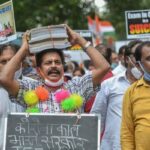At a time when history has become an ideological site for the redrawing of the idea of India, we write with the conviction that as professional historians we must be responsible in the interpretations of facts and arguments, especially when writing for the wider public.
It is with the same conviction that we responded to Shonaleeka Kaul’s “The Idea of India: A Historical Corrective” published in The New Indian Express. In this reply to her rejoinder, “The Empire Strikes Back: Ad Hominem as History” we restate the fallacies and inaccuracies in Kaul’s articles which suggest that the idea of India is based on an “ethnic” and geographical unity that can be traced back to the 5th century BCE.
Imaginations of space are not imaginations of nations
Kaul notes historians, geographers, and political scientists distinguish between the idea of a nation and nation-state. However, the creation of India as a distinct geo-body, as “national space,” and its cultural and territorial configuration as Bharat is very much a product of the 19th century. According to Kaul, a nation is defined as “a notion consisting of a jointly held sense of belonging to a common territorial and cultural entity.” Further she claims that her article “goes on to demonstrate concrete examples of such an understanding of India in history.” Yet, it is disingenuous for Kaul to argue that she is speaking of an idea of India that is merely cultural when she emphasises the importance of its presumed territorial unity.
Also read: Are We in for a Foundational Shift in India’s Nationalist Imaginary?
Kaul claims that the idea of contemporary India rests on imaginations of geography and space as spelt out in several ancient texts. She suggests that the Indian nation has had geographical coherence and meaning since ancient times. However, B.D. Chattopadhaya has ably cautioned us against making such anachronistic connections between early representations of space, geographical imaginations, and the modern nation. In other words, it is ahistorical to seamlessly project categories and concepts of the present (nation) onto older cultural categories like Bharatavarsha. All students of history are taught that we must strive to grasp the past on its own terms and not reduce it to the present.
Undoubtedly, the idea of a modern Indian nation has been a contentious one. While some made a case for envisioning India as a composite nation of many cultures, others including Muhammad Ali Jinnah and V.D. Savarkar held the view that nations were based on religious communities. The ideas of citizenship and the nation-state based on Savarkar’s understanding of the nation are especially pertinent in India today. Such religious nationalism in India, based on unequal citizenship rights, is connected to exclusionary laws and processes like the Citizenship (Amendment) Act and National Register of Citizens. Thus, it is the ethical responsibility of historians to guard against anachronisms and abuses of history to justify notions that exclude any group on the basis of language, religion, or ethnicity.

A painting depicting the battle of Kurukshetra of the Mahabharata. On the left, the Pandava hero Arjuna sits behind Krishna, his charioteer. On the right is Karna, commander of the Kaurava army. Credit: Wikimedia Commons
In essence, in the attempt to link a reductionist and simplified understanding of geographical imaginations to contemporary ideas of national space and the nation-state, Kaul does a hop-and-skip citation of the Mahabharata, Vishnu Purana, and Xuanzang’s travel accounts before taking a giant leap to incorporate the philosopher Shankaracharya. Throughout the broad period she covers, from the ancient past to the present, there were many conflicting geo-bodies, spatial practices and political formations, spanning the shifting borders of empires and sultanates. In her rejoinder, when questioned, Kaul adds uncontextualised references to al-Biruni and Abul Fazl to argue that all these imaginations of space are “nonetheless hardly distinguishable.”
However it is important to note who Kaul cites, how she cites them, and more importantly who she leaves out. In her original piece, there was no room for spatial imaginations from the cosmopolitan world of the Delhi Sultanate and the Mughal empire or other genres of writing in Persian, Arabic, Sanskrit, or regional languages. For example, there is little space for the cultural imagination embedded in the hagiographies of Sufi saints about travel and space studied to such good effect by Simon Digby in this framework.
Also read: The Changing Face of Sufism in South Asia
Despite her subsequent references to al-Biruni and Abul Fazl, in Kaul’s arguments the Sanskritic “tradition” appears as the glue binding Indian culture and the nation together. This vast corpus of texts cannot be read in a linear fashion to fit into a preordained idea of India from the ancient past.
We should also not be surprised that complex notions of the spatial organisation of the world existed in pre-modern India. While cosmological and spatial imaginations certainly exist in these texts, Kaul reads into these imaginations “ethnic” and “geographic” criteria to serve as the basis for the nation. Yet making ancient “ethnic” categories into a basis for belonging introduces the fundamental question of who gets to belong to the nation and who is to be excluded. While there were different evocations of community and selfhood, to suggest that these were subsumed into a unified geo-cultural space since the 5th century BCE is not substantiated by the vast and rich body of interdisciplinary work by scholars of Persian, Sanskrit and regional language texts.
Kaul is troublingly also selective in her deployment of the work of scholars including Diana Eck and Sheldon Pollock. She relies on Eck’s assertion that India is a sacred geography forged by pilgrimage over centuries. This is a shaky pedestal upon which to build an argument about the nation. Sacred space is not the same as national political space. Similarly, when Pollock writes of a South Asian cosmopolis bound by Sanskrit, his writings are clear that this Sanskrit cosmopolis does not map onto modern-day India either culturally or territorially. Pollock in fact highlights the instability of geographical imaginations of Bharatavarsha (The Language of the Gods in the World of Men, 2006, p. 193). To tie this idea of a Sanskrit cosmopolis stretching across South, Central, and Southeast Asia to the cartography of Indian nationhood is further evidence of the kinds of selective reading we highlighted in our rejoinder. In fact, Kaul’s The Making of Early Kashmir (2018) has been subject to extensive criticism for its de-contextualised and anachronistic use of sources.
Also read: The Myth of ‘Sanskrit Villages’ and the Realm of Soft Power
Nehru or otherwise?
There is a lack of clarity in Kaul’s writing about her argument’s relationship to the Nehruvian “idea of India” – cultural unity produced by diversity. The idea of India is multiple, for civilisational narratives are part of modern national projects. If Kaul wishes to speak of unity in diversity, as she does in her rejoinder, then she seems to be in agreement with the Nehruvian idea of India as enunciated in the Discovery of India (1946). But, this is not at all what her original article suggested. Why write a “corrective” if Kaul is merely trying to reinvent the wheel?
It would be disingenuous to believe that historical debates in public forums are not shaped by their contexts, just like the “cultural” texts and connections Kaul discusses. We are concerned about the world that Kaul’s conception of the past is taking us towards at a time when the “new republic” of Hindutva has been announced. In a moment when history is being used to aid and enable majoritarian nationalism, it is more incumbent than ever that historians become part of these debates and intervene in ethical and responsible ways.
Malavika Kasturi is Associate Professor, Department of Historical Studies, University of Toronto
Mekhola Gomes is Postdoctoral Fellow, Centre for South Asian Civilization, University of Toronto Mississauga.




